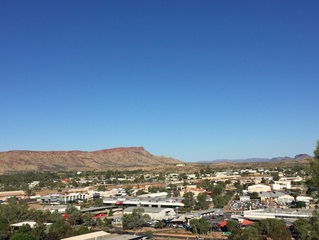Alice Springs

A two week tour of Australia’s Northern Territories and the Red Centre
For full itinerary please click here.
Part 2: Alice Springs
Alice. What thoughts immediately “spring” into your head? A Nevil Shute novel or a Roy Chubby Brown song? Is this why the name is famous?
Alice Springs has a reputation bigger than the small plot it occupies in the middle of a huge, red, dusty desert. Although still 462 km away, most people use Alice as a launch pad for a pilgrimage to Uluru (Ayers Rock), even though the rock has its own airport now.
The tourism boom in the outback is still in relative infancy, although there are a few modern chain hotels on the edge of town. Alice may not be the dusty outpost it once was, but if you turn up after 5pm the place will have battened down its hatches. It will look deserted, except for a few bars, where the beer is flowing. Living in Alice is thirsty work.
From the air, Alice is nestled on a flat red dusty plain between the spiny backbones of the MacDonnell mountain ranges. Around 25,000 people live miles from anywhere in the red dusty centre of Australia. It is edged by the Todd River and two hills: Billy Goat Hill and Anzac Hill. You can climb the latter for a great view of the town.
During the day, the town comes to life with interesting museums, boutique shops and cafés in Todd Mall.
Don’t laugh, but I particularly enjoyed the Old Gaol and the National Pioneer Women’s Hall of Fame. The remoteness of the town makes this exhibition all the more interesting. For a long time Alice was just a lonely telegraph station at the end of the Ghan railway line.
Women started to accompany their husbands, who set up cattle stations. They took on roles as midwives, teachers and nurses. With these more feminine skills, Alice became a settlement, rather than a stopping off point. It became a home, rather than somewhere just to water the horses and camels. (Yes, there are camels, from Afghanistan. They were the trains before the railway opened in 1929, and the reason the modern train is called the Ghan.)
Its history, however, goes back far deeper as a town in the middle of Aboriginal “countries”. While the mystical and fascinating stories still enthrall explorers, the indigenous population has had a rough ride, seen as animals, and treated as such. With such lack of respect it's little wonder that today’s problems of drink and unemployment may be a reflection of the past.
White and black have never fully assimilated each other, absorbed an alternative way of life or become a melting pot of cultures. Whether you look at the situation as Europeans and locals, whites and blacks or infiltrating power and indigenous, the two elements have still not accepted the position of the other, although there are plenty of people on both sides making huge efforts to change things. This isn’t about living in harmony, or even mutual respect. It’s about accepting and living contrasting lives side by side. The Aborigines believe they are tied to the land. Traditionally, there is no time structure in their society. If you’re hungry you eat; if you’re tired, you sleep. That doesn’t overlap well with a modern society governed by clocks, timetables, technology, rules and regulations. There are so many issues that it’s easy to see how this tinderbox could go up in flames.
And there are no answers. How do you enforce a structure on a free-flowing society without damaging its culture? How do you create jobs and opportunities for people who don’t seek a European/ Western life? How do you ensure law and order, when the approach of each way of life means accepting the other, and leaving each to their own devices?
Notes on Alice Springs
We stayed at: The Double Tree, Hilton
We ate at: The Overlanders Steakhouse (beef, kangaroo, crocodile), Uncles Tavern (beer and pizza).
Part 1: Darwin
Part 3: Uluru & Kings Canyon
Part 4: Kakadu, Katherine & Litchfield
More photos



 RSS Feed
RSS Feed
